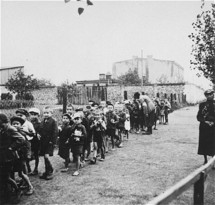Survivors mark 65th anniversary of end of Lodz ghetto
Mary Sibierski
LODZ, Mary Sibierski - Holocaust survivors gathered in Lodz Wednesday to pay homage to 220,000 Jews who perished in the Polish city's ghetto during World War II, 65 years after its liquidation by German Nazis.
"That we are here symbolizes that we won that war, we the Jewish nation and the nations of Europe are alive," Lodz Jewish community leader Simcha Keller told a crowd of hundreds at the ornate wrought iron gate of the historic Jewish cemetery.

"I'm over 80 so now is my last opportunity to really tell my story, it's painful," said Lodz ghetto survivor Irving Stal, 81, who came with his children from Toronto.
"For many years after the war, I didn't want to speak about it," said Stal, who originally hailed from Strykow, a small community near Lodz.
A fellow Jewish survivor from the same town, Natan Szafran, 84, now a resident of Las Vegas, also travelled to Poland with his family.
"My end is coming near, so it's time to show my children and grandchildren everything," he said.
"I'm very proud of my father, that he's come back to tell his story. It's important he does because there are people who say this never happened," his 49-year-old daughter Karyne Szafran said.
The survivors also remembered the liquidation of a gypsy ghetto in Lodz, where some 5,000 Austrian Roma perished.
Nazi Germany set up the Lodz ghetto -- the Litzmannstadt ghetto in German -- in 1940, enclosing there around 220,000 Jews from Poland and other European countries such as Austria, Germany and the former Czechoslovakia.
It was the first ghetto created by the Nazis in occupied Poland and the last to be liquidated. Only the infamous Warsaw ghetto was larger.
Used primarily as forced labourers for the Nazis' Third Reich, some 50,000 Jews died of exhaustion, hunger and disease inside an area of four square kilometres (1.5 square miles).
Other ghetto residents were sent to their deaths in the gas chambers of the Auschwitz-Birkenau and Kulmhof am Ner concentration camps.
Only 830 survived people the Lodz ghetto's liquidation in August 1944.
Poland's third largest city with a population of 780,000, Lodz was the country's textile capital throughout the 19th and most of the 20th centuries.
Today just a handful of Jews live in Lodz, but the city's Jewish cemetery remains the largest of its kind in Europe with more than 230,000 people buried there since 1892.
Poland was home to Europe's largest Jewish community prior to World War II with a history reaching back nearly one millennium. Some three of the six million European Jews who perished in the Holocaust were Polish citizens.
Poles are gearing up to commemorate 70 years since their homeland was attacked by Nazi Germany on September 1, 1939, sparking the war. The Soviet Union attacked from the east days later.
According to figures published this week by Poland's Institute for National Remembrance (IPN) between 5.62 to 5.82 million Polish citizens perished during the war.
The vast majority were killed by Nazi Germany, but the IPN estimates that some 150,000 perished at the hands of the Soviets.
--------------------------------------------------------------------------------------------------------------------------